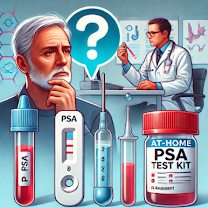At-home prostate tests have gained popularity as a convenient way for men to check their PSA (prostate-specific antigen) levels. However, recent investigations, including a BBC News analysis, have raised significant concerns about their reliability and potential risks. Below is a ranked list of the most critical issues associated with these home testing kits.
1. Inconsistent and Inaccurate Results
The most alarming issue with rapid PSA tests is their questionable accuracy. In the BBC’s analysis of five different tests:
One test failed to work entirely.
Three tests returned a negative result.
One test falsely indicated a high PSA level.
A laboratory blood test taken the same day showed a much lower PSA reading (0.27 ug/l) than the one test that falsely indicated an elevated PSA level (above 4.0 ug/l). This inconsistency can lead to unnecessary anxiety or a dangerous false sense of security.
2. Lack of Medical Supervision and Interpretation
Unlike NHS tests that involve consultation with a GP, at-home kits provide results without medical context. Prostate Cancer UK has warned that these tests can mislead users because:
A high PSA level does not necessarily mean cancer but requires further medical evaluation.
Some cases of prostate cancer may not show high PSA levels at all.
Without professional guidance, individuals may misinterpret results, leading to either undue worry or missed early warning signs.
3. Misleading Marketing and Lack of Regulation
While the UK’s Medicines and Healthcare products Regulatory Agency (MHRA) states that PSA tests should not claim to detect cancer, many at-home tests use vague language such as “screening” or “assessing prostate cancer risk.” Furthermore:
Some kits are sold with instructions labeled "for professional use only."
The British In Vitro Diagnostics Association warns that these tests may not provide an accurate picture of prostate health.
4. Difficulty in Usage
Many men without medical experience struggle with using the tests correctly. The procedure involves:
Piercing the skin with a lancet.
Collecting blood with a pipette.
Mixing the sample with a chemical reagent.
Placing the sample in the test cassette.
Errors in any step can lead to inaccurate results, making the test unreliable.
5. Psychological and Emotional Impact
Incorrect results can cause significant distress. Online reviews reflect this concern, with users reporting:
Anxiety after false positive results.
False reassurance from negative results when later diagnosed with prostate cancer.
In one case, a man who took two home tests for “peace of mind” received negative results but was later diagnosed with stage four prostate cancer through an NHS test.
6. The Need for Better Guidelines and Awareness
Prostate Cancer UK attributes the rise in home testing to a larger issue—many men are unaware that they can request PSA tests from their GP. Current NHS guidelines:
Recommend PSA testing for men over 50 (or 45 for high-risk groups).
Do not proactively offer testing, leaving it to individuals to request it.
Sir Chris Hoy’s public prostate cancer diagnosis in October 2024 has renewed calls for lowering the age for high-risk groups and improving guidelines to allow doctors to discuss PSA testing more openly with patients.
Conclusion: The NHS Route Is Still the Best Option
Despite the convenience of home PSA tests, experts strongly advise seeing a GP for accurate and context-based testing. NHS tests provide:
Lab-processed PSA readings with greater accuracy.
Professional interpretation of results.
Consideration of other risk factors such as age, family history, and ethnicity.
The UK government has tasked the National Screening Committee with reviewing current prostate cancer testing guidelines, with results expected later this year. Until then, the safest approach remains consulting a healthcare professional rather than relying on at-home PSA tests.

